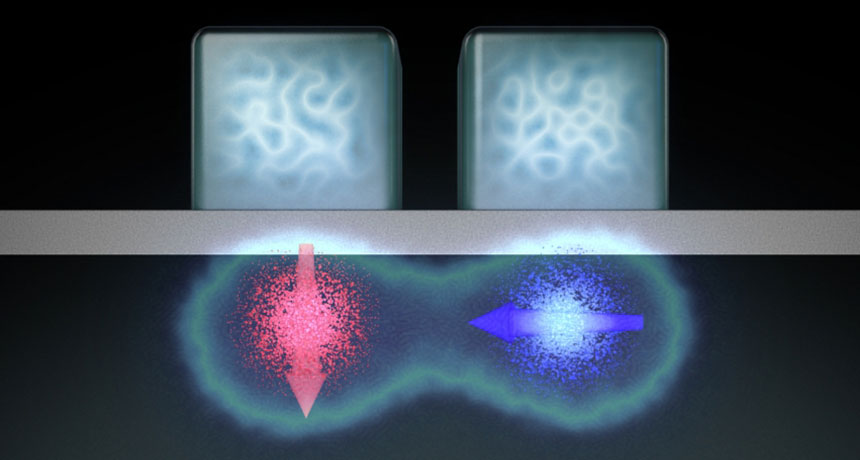Future quantum computing could exploit old technology
Modified silicon transistors perform basic logic tasks

QUANTUM ELECTRONICS A new quantum logic gate in silicon manipulates the spins (arrows) of a pair of electrons (red and blue), as shown in this illustration.
Tony Melov/UNSW
Silicon transistors have been converted into the basic components of a quantum computer.
Using modified versions of transistors used in smartphones, tablets and desktop computers, Australian engineers have built the first quantum logic gate in silicon for performing quantum computations. The gate, described October 5 in Nature, uses the value of one quantum bit within a transistor to determine whether to change the value of a quantum bit in another transistor. The researchers say they have demonstrated all the fundamental components needed to build a silicon-based quantum computer, which could swiftly perform tasks like factoring large numbers and searching huge datasets.
Other researchers say that while the silicon work is an impressive physics feat, engineers pursuing alternate quantum computing platforms are farther along and years ago demonstrated gates that manipulate two quantum bits, or qubits. But silicon research has a built-in advantage, says Andrew Dzurak, an electrical engineer at the University of New South Wales in Sydney who led the study. There’s a global manufacturing infrastructure for printing tiny electronic components onto silicon, allowing engineers to more cheaply and easily test — and ultimately produce — their creations.
Traditional computers perform calculations with binary bits: different voltages of electricity surging through silicon chips correspond to 0s or 1s. Those bits get manipulated when they pass through logic gates made of transistors. For example, an AND gate outputs a 1 when two incoming bits are both 1; otherwise it produces a 0. Computers perform such operations in response to every keystroke, mouse click and screen touch.
Quantum computers would work on a similar principle, but qubits would be encoded in delicate properties such as a single electron’s spin. Qubits can be 0, 1 or a blend of both simultaneously, a phenomenon called superposition that should enable quantum computers to perform certain calculations more efficiently.
Dzurak’s team modified silicon transistors to hold single electrons and then placed two transistors close together at temperatures just above absolute zero. Microwave pulses and magnetic fields coaxed the two electrons serving as qubits to interact. The researchers created two-qubit logic gates that flipped the spin of one electron if the other electron had a particular spin. “It’s state-of-the-art control of silicon qubits,” says Chris Monroe, a physicist at the Joint Quantum Institute at the University of Maryland in College Park.
Dzurak says the next step is scaling up the technology to integrate several gates and multiple qubits. “You can build up any calculation you want with a combination of one- and two-qubit gates,” he says.
Monroe, who works on a competing platform that uses ions as qubits, says to hold off on the hype. Scientists demonstrated two-qubit gates with ions in 1995, he says, so silicon is way behind. He adds that dirt and other surface aberrations quickly interfere with electron spins, an issue that should worsen as the computer is scaled up in size and the number of qubits increases. “I don’t find anything about this scalable,” he says. “I don’t really consider silicon competition.”
Building a quantum computer of any type remains a tremendous challenge, largely due to the fragility of those quantum superposition states. Monroe admits silicon researchers have one giant leg up on the competition: “Our systems are so much cleaner, but we don’t have the infrastructure to print chips with a million atoms on it.” That’s the main reason why Dzurak says it’s better to build around the infrastructure in place. He plans to team with an electronics manufacturer to produce quantum computer chips.







